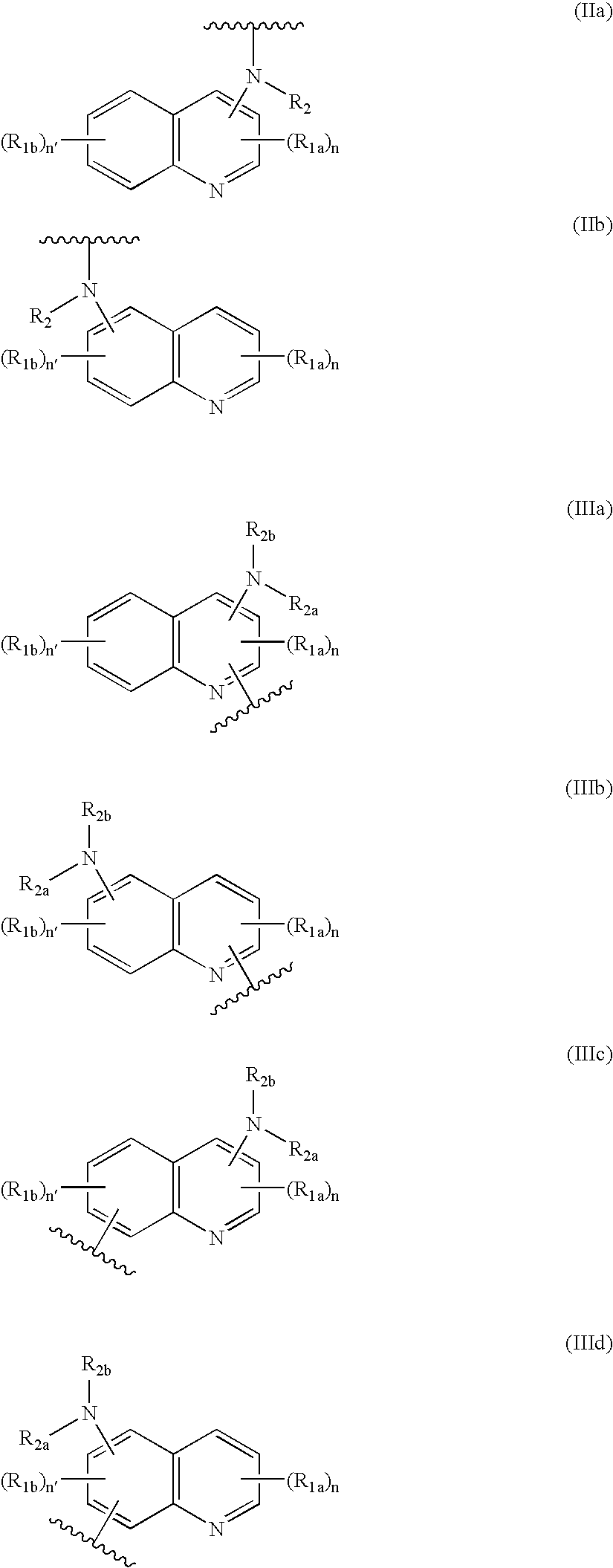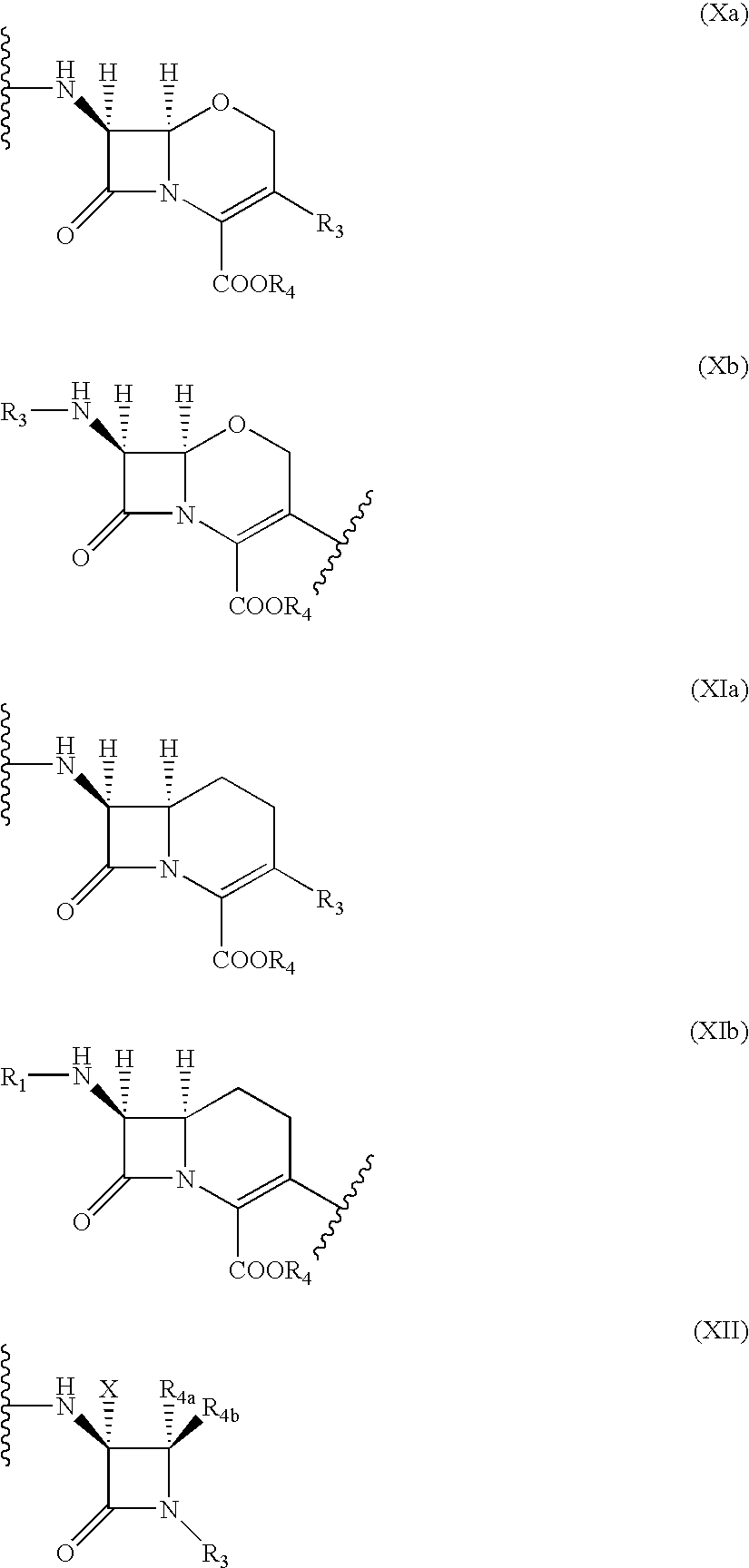Hybrid molecules QA, wherein Q is an aminoquinoline and a is an antibiotic or a resistance enzyme inhibitor, their synthesis and their uses as antibacterial agent
a technology of a hybrid molecule and an aminoquinoline, which is applied in the field of hybrid molecules qa, can solve the problems of serious problems in the propagation of bacterial strains resistant to practically all the antimicrobial agents currently available, and achieve the effect of improving the inhibitory activity and reducing the effectiveness of the agents
- Summary
- Abstract
- Description
- Claims
- Application Information
AI Technical Summary
Benefits of technology
Problems solved by technology
Method used
Image
Examples
example 1
Preparation of an Aminoquinoline-Penicillin Hybrid, ref PA 1007
(2S,5R,6R)-6-{[1-(7-Chloro-quinolin-4-yl)-piperidine-4-carbonyl]-amino}-3,3-dimethyl-7-oxo-4-thia-1-aza-bicyclo[3.2.0]heptane-2-carboxylic acid 2,2-dimethyl-propionyloxymethyl ester
[0158]
1.1. 1-(7-Chloro-quinolin-4-yl)-piperidine-4-carboxylic acid
[0159] A mixture of 4,7-dichloroquinoline (17.4 g, 0.09 mol), of isonipecotic acid (23.8 g, 0.18 mol) and phenol (46.3 g, 0.49 mol) is heated at 120° C. under magnetic stirring for 24 hours. After cooling, the reaction mixture is diluted with 400 mL of ethyl acetate, filtered and the precipitate is washed with water. This precipitate is then recrystallized by dissolution in 300 mL of hot (100C) 10% (w / v) aqueous Na2CO3 and precipitation at 0° C. by addition of 2M HCl until pH 5. The precipitate formed is filtered off and then washed successively with water, acetone and diethyl ether before being dried under vacuum. The product is obtained as a white powder (18.4 g, 72%).
[016...
example 2
Preparation of an Aminoquinoline-Penicillin Hybrid, ref PA 1008
(2S,5R,6R)-3,3-Dimethyl-7-oxo-6-[3-(quinolin-8-ylamino)-propionyl-amino]-4-thia-1-aza-bicyclo[3.2.0]heptane-2-carboxylic acid 2,2-dimethyl-propionyloxymethyl ester
[0163]
[0164] PA 1008 is prepared according to the procedure described in Example 1.2 from 4.3 g of 3-(quinolin-8-ylamino)-propionic acid (19.9 mmol) (prepared according to the method described by Z. J. Beresnevicius et al., Chem. Heterocycl. Comp. 2000, 36, 432-438), 10.0 g of POM-APA-Ts (19.9 mmol), 6.5 mL of N-methylmorpholine (59.1 mmol) and 10.3 g of PyBOP® (19.9 mmol). PA 1008 is obtained after purification by liquid chromatography on silica gel (SiO2 60A C.C 6-35μm, eluent: n-hexane / ethyl acetate 55 / 45 v / v) and recrystallization from diethyl ether / n-hexane as a yellow powder (2.3 g, 22%).
[0165] IR (KBr) cm−1: (C═O) 1784, 1755, 1667. 1H NMR (300 MHz, 298K, CDCl3) 6, ppm: 1.16 (9H, s), 1.37 (6H, s), 2.64 (2H, t, J=6.6 Hz), 3.61 (2H, m), 4.34 (1H, s), 5.4...
example 3
Preparation of an Aminoquinoline-Penicillin Hybrid, ref PA 1012
(2S,5R,6R)-6-[2-(7-Chloro-quinolin-4-ylamino)-acetylamino]-3,3-dimethyl-7-oxo-4-thia-1-aza-bicyclo[3.2.0]heptane-2-carboxylic acid 2,2-dimethylpropionyloxymethyl ester
[0166]
3.1. (7-Chloro-quinolin-4-ylamino)-acetic acid
[0167] This compound is prepared by modification of the method described by E. O. Titus et al. (J. Org. Chem, 1948. 13, 61). A mixture of 4,7-dichloroquinoline (30.0 g, 0.15 mol), glycine (25.0 g, 0.33 mol) and phenol (80.0 g, 0.85 mol) is heated at 120° C. under magnetic stirring for 24 hours. After cooling, the reaction mixture is diluted with 1 L of diethyl ether and extracted with 1 L of 10% (w / v) aqueous Na2CO3. The aqueous phase is warmed with decolorizing carbon (Norit A) at 100° C., filtered and neutralized to pH 5 at 0° C. with 2 M aqueous HCl. The precipitate formed is filtered off and washed successively with water, acetone and diethyl ether before being dried under vacuum. The product is obt...
PUM
| Property | Measurement | Unit |
|---|---|---|
| temperature | aaaaa | aaaaa |
| temperature | aaaaa | aaaaa |
| temperature | aaaaa | aaaaa |
Abstract
Description
Claims
Application Information
 Login to View More
Login to View More - R&D
- Intellectual Property
- Life Sciences
- Materials
- Tech Scout
- Unparalleled Data Quality
- Higher Quality Content
- 60% Fewer Hallucinations
Browse by: Latest US Patents, China's latest patents, Technical Efficacy Thesaurus, Application Domain, Technology Topic, Popular Technical Reports.
© 2025 PatSnap. All rights reserved.Legal|Privacy policy|Modern Slavery Act Transparency Statement|Sitemap|About US| Contact US: help@patsnap.com



